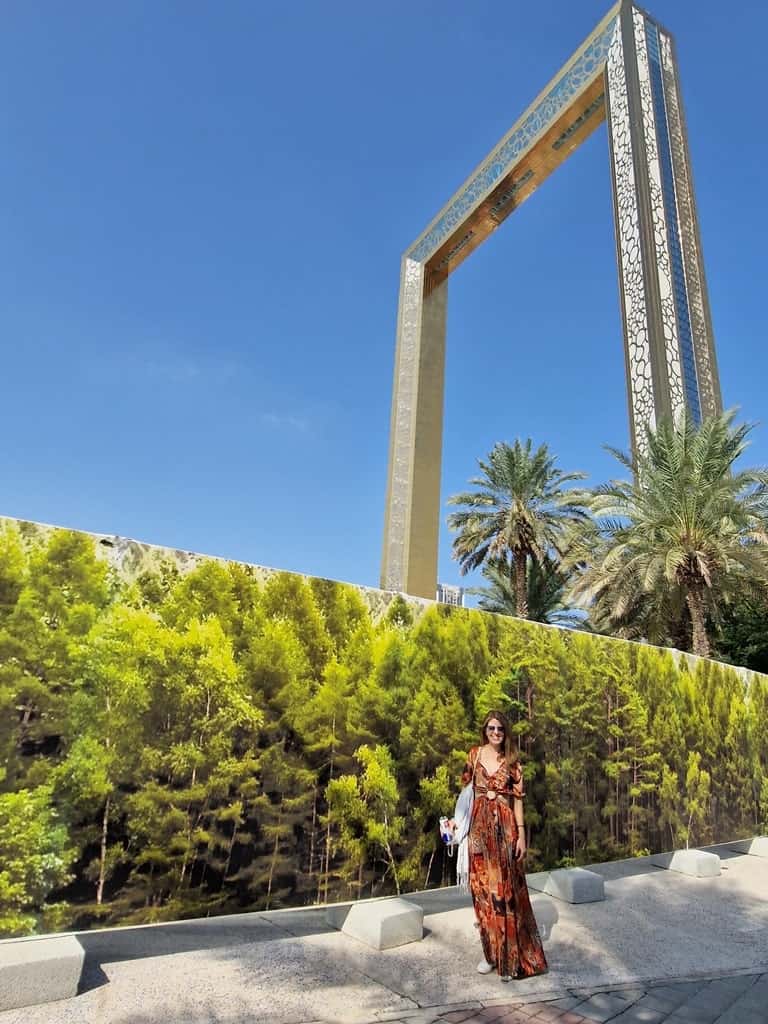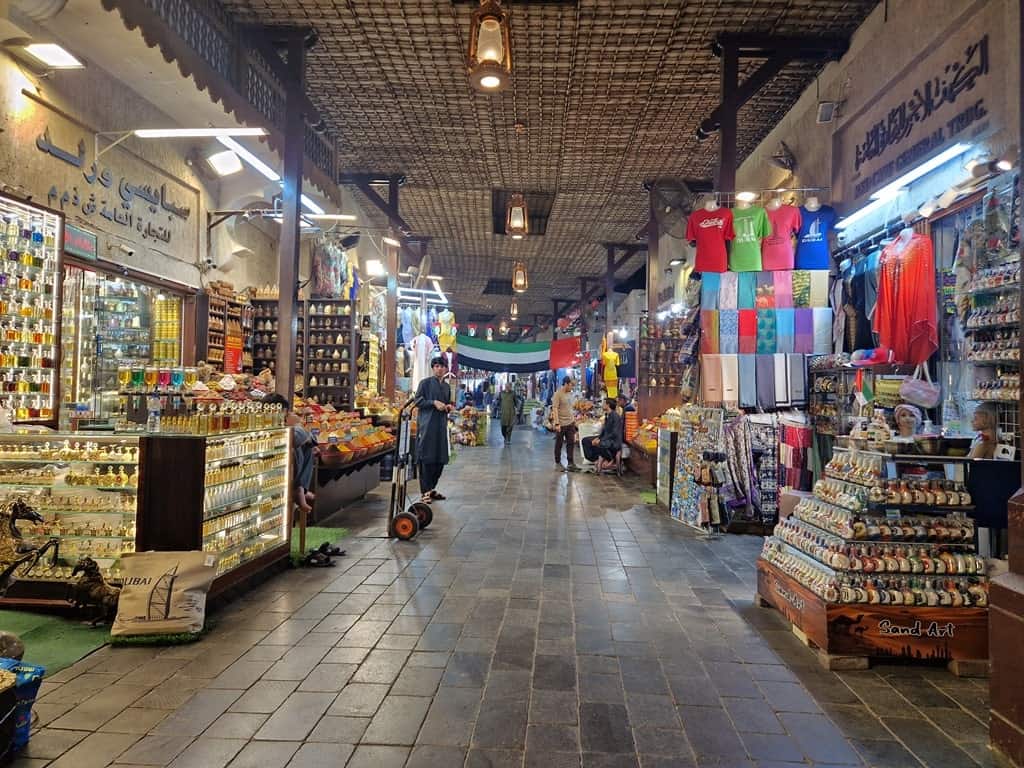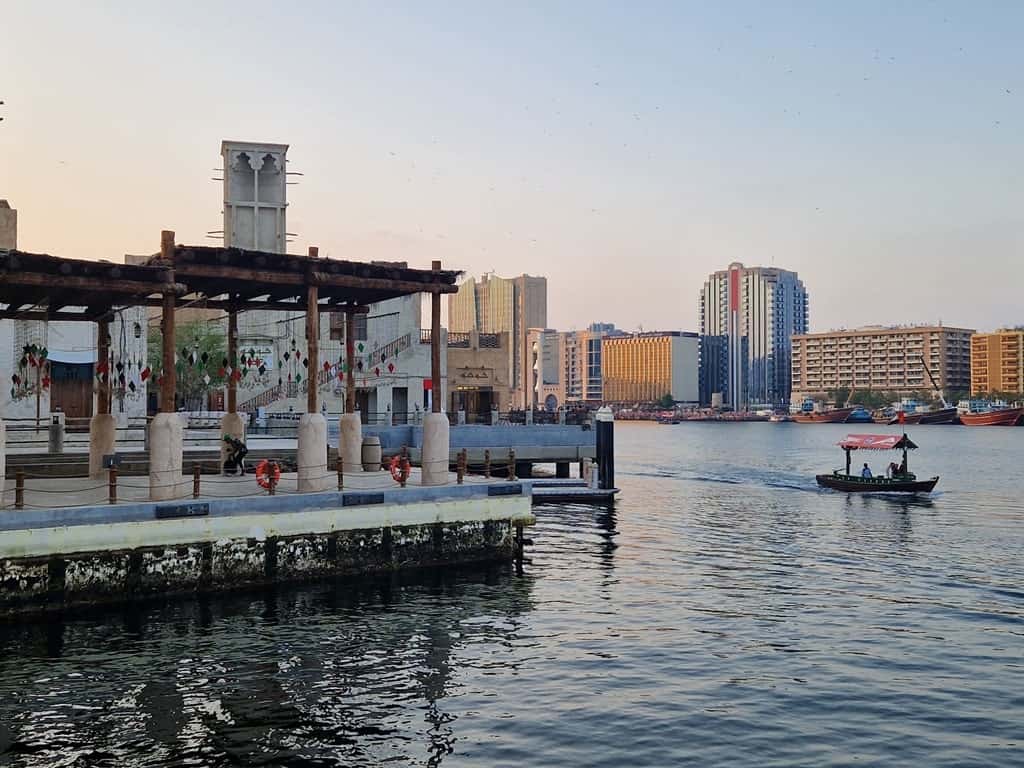Looking for history in Dubai? Then head to Bur Dubai. Literally “Old Dubai”, this part of the city is a warren of traditional buildings, old cafes, tiny restaurants, and souks to get lost in.
Set along the banks of Dubai Creek, it’s here that the city’s trading heritage can still be strongly felt. Wander the streets, visit cultural sights, and stop by a few culinary hideouts — these are some highlights to put on your itinerary for Dubai’s old town.
Table of Contents
Exploring Dubai Old Town
Explore the Al Fahidi Historical Neighbourhood
Also known as Al Bastakiya, the Al Fahidi Historical Neighbourhood is one of the oldest parts of Dubai. It was originally established in the 1890s, first growing as a hub for trade by wealthy Persian traders who set up shop here looking to profit from Dubai’s booming pearl industry. In fact, the district took its name from the Iranian town of Bastak.

Sadly much of the district has been lost to development, but around half of what was originally, there remains. You’ll still find narrow lanes, old cafes, and cultural sights in this tiny pocket of the city, with repurposed buildings now housing art galleries and boutiques.

Visit the Coffee Museum
One of the many intriguing places to visit within the boundaries of Al Bastakiya is the Coffee Museum. As you may be able to tell, this is the place to come to learn all about the miracle bean that is coffee.
Over the years coffee has played a large part in the trade that’s passed through Dubai and has long been an important element of Arabic culture. Stopping by the coffee museum allows you to find out just how important coffee has been to Dubai (and the world), learn about different varieties and flavors of coffee from around the world, and even sample some local coffee too.
The setting, in a traditional building complete with wind towers and antique displays, really adds to the charm.

Learn More at Sheikh Mohammed Centre for Cultural Understanding
This non-profit cultural center is another one of Al Bastakiya’s sights that makes full use of the historic buildings of the district. The Sheikh Mohammed Centre for Cultural Understanding provides an insight into the UAE’s history and regional traditions, aiming to break down cultural boundaries.

The center hosts a number of different events across the year, including Q&A sessions, workshops, and tea parties, where you can sample traditional cuisine and snacks. There’s a variety of different activities to get involved with, including learning Arabic.
Glimpse the Old Town from above at Dubai Frame

The Dubai Frame is exactly what it says it is: a frame. In fact, it’s the largest frame in the world, standing at just over 150 meters tall and over 95 meters wide. But it’s not just a giant art installation — this was actually the prize winner in a competition to design a new observation tower in Dubai.
But there’s something particularly unique about the Dubai Frame. At the top of the frame, an observation deck allows visitors to see not only modern Dubai, with all its skyscrapers, but also Bur Dubai and its wind towers and souks. There’s also a glass-bottom floor for extra thrills, while a museum within the Dubai Frame tells both the history and the potential future of the city too.
Refresh yourself at the Arabian Tea House

Once the house of a pearl trader, this historic structure has been lovingly restored and transformed into the Arabian Tea House. Designed to stay true to the heritage of Al Bastakiya, the interiors here are laden with traditional charm — think wicker furniture, splashes of blue, exposed stone walls adorned with photos of Old Dubai, and curving archways and elaborate columns.
Make sure to grab a seat on the elegant outdoor terrace and get ready to sample one of the best breakfasts in the city: a medley of beans, labneh, scrambled eggs, olives, and cheeses.

Go for a boat ride on the Dubai Creek
Dubai Creek has long been an integral thoroughfare for the city. It was from this convenient natural port that the city’s fortunes in terms of pearl fishing and trading took off. Although Dubai Marina in the modern part of the city may be packed with sparkling yachts, Dubai Creek retains its old-school charm.

Here, water taxis called abras still ply the waves, ferrying passengers between Deira and Bur Dubai. Locals still utilize the abras to get across the creek on their way to and from work, and at just 1 AED, it’s a very affordable way to experience some local life in the otherwise cutting-edge city.
Visit One of the Souks
Souks are traditional Arabic markets and have long been the backbone of merchants’ livelihoods in Dubai. But despite the many malls in the city, these marketplaces remain an important place for trade and commerce. One of the most famous in this old part of Dubai is the aptly named Gold Souk.

This iconic market is absolutely crammed full of gleaming golden jewelry and precious stones. By some estimates, it’s believed that the Gold Souk plays host to around ten tons of gold at any time.

This treasure trove is government regulated, which means all the gold or jewels here are authenticated. Haggling, however, is still part of the purchasing process, which means you can still snap up some relative bargains — if you’re good at it!
Shop for fabrics at Meena Bazaar
As well as gold, textiles, and fabrics have also passed through the mercantile districts of Dubai. Meena Bazaar, a traditionally Indian-run marketplace (it’s sometimes referred to as “Little India”), is the center for all things textile in the old town. Here you can explore alleys lined with colorful displays of accessories, shoes, and clothing, all on a backdrop of Dubai Creek.
But it’s not only about textiles. Among the many businesses on offer here you’ll also find shops selling ceramics, spice merchants, and the chance to pick up a few low-cost snacks to fuel your shopping: How about some fresh samosas and a cup of chai as a pick-me-up?

Eat your fill at Al Mallah
Opening its doors back in 1979, this low-key eatery has been a local favorite for Lebanese fare for decades. Particularly, Al Mallah serves up some serious shawarma, which is certainly saying something in a city where shawarma can be found all over the place.
Though shawarmas are the top menu item here, there’s a wide range of dishes to get stuck into — falafel, hummus, mixed grills, all manner of snacks and juices. It’s a no-fuss eatery but offers up good value for money and both air-conditioned indoor seating as well as a handful of shaded roadside tables.
Take a stroll down Hindi Lane
An estimated three million Hindus are living in the UAE. Many of those who call Dubai home regularly make their way to the only Hindu temple in the city, which is right here in the old town. It’s really two temples — one dedicated to Shiva, the other to Krishna — that make up this 1958 religious complex.
However, it’s the run-up to the complex, Hindi Lane, that will most intrigue visitors. The alleyway is packed full of vendors selling all manner of temple goods, flowers for use in puja ceremonies, statues, and even a few bakeries and other snack shops. Take your time when wandering down here and soak up this colorful side of Dubai.
Take a breather at Ras al Khor Wildlife Sanctuary

Those looking for a slice of nature amid the modern metropolis of Dubai should make their way to this wetlands reserve. Located at the head of Dubai Creek, Ras al Khor Wildlife Sanctuary (RAWS) is a conservation area designed to preserve a slice of Dubai Creek’s natural ecosystem.
It’s particularly for birdwatching, as a variety of species can often be found here (and sometimes in large numbers), including kingfishers, herons, and even flamingos. It’s good to head down here at low tide when birds can be found picking their way across the flats and mangroves. It’s free to enter, features three bird hides, and views of the skyscrapers in the distance.
Watch the world go by at the Dhow Wharfage

Though the trade along Dubai Creek was how the city initially became wealthy, the days of dhows packing the waterway are now a thing of the past. However, remnants of this mercantile heritage can still be seen at the Dhow Wharfage.
Simply head south from the Spice Souk along the water’s edge and you’ll come across an array of wooden boats, painted in a rainbow of colors. These boats may seem like heritage pieces but they are, in fact, still working, zipping between the cities of the Emirates, as well as Pakistan, India, and Iran. Stay for a while and you may catch sight of an interesting array of cargo being unloaded onto the waterfront promenade.
Check out Dubai Museum at Al Fahidi Fort

Al Fahidi Fort is the oldest building still standing in the city. It was built back in 1787 to protect the settlement that would eventually become Dubai — mainly from raids by neighboring, hostile tribes. For a long time, it was the fortified residence of the ruler of Dubai and has since been used as a weapons arsenal and a prison.
Today the square-shaped structure and its defensive towers, constructed from coral and mortar, still stand strong. The entranceway is flanked by two cannons, harking back to its days as a military garrison.
However, inside it is no longer a fort or a residence but instead plays host to Dubai Museum. Opening in 1971, the museum offers an insight into Emirati culture, with a number of different antiques and artifacts on display from across the region.

Admire the architecture of Diwan Mosque
Built in 1985, Diwan Mosque may not be the oldest, the biggest, or even the most beautiful mosque in Dubai, however, it does offer a fascinating chance to gain an insight into Islamic culture in Old Dubai. Though externally quite simple in terms of architecture, it does feature a curiously squashed onion dome and a graceful minaret.

Non-Muslim visitors are not usually allowed to enter, but there is a cultural tour available which is run through the Sheikh Mohammed Centre for Cultural Understanding. The tour takes visitors into the mosque itself, with guides explaining the architecture and significance of the space, before welcoming them back to the cultural center for tea and conversation about the mosque and Islamic culture.
Transport Yourself to Ancient Egypt at Wafi City
Wafi City is more than just a mall. At this comprehensive complex of contemporary facilities, you’ll find private residences, eateries, a hotel, and even a nightclub — and many shops, of course. The most intriguing thing about Wafi City is that it is themed in Ancient Egypt.
This theme park-esque mall complex, complete with pyramids, a replica of Karnak, and statues of pharaohs, is a fun place to spend some time in Old Dubai. When it opened in 1991 it was actually one of the first malls in Dubai, and marks a start of a wholly new and very modern heritage for the city. Despite its age, Wafi City is an attractive haven for shoppers; the stained-glass pyramid-shaped atrium is particularly impressive.

Gorge on South Indian cuisine at Calicut Paragon
If you’re a fan of South Indian fare, and you’re looking for a budget-friendly bite to eat, then Calicut Paragon should definitely be on your food itinerary of Old Dubai. They have a few locations across Dubai, but the one in Karama Market is the original and the best.
Despite its affordability, the quality of food here is top-notch, which just makes Calicut Paragon even better. You’ll be able to sample a whole range of dishes, from fish curries to biryani, with thali sets served on banana leaves a particular highlight. The laid-back spot is also perfect for vegetarians thanks to the many vegetable plates on the menu.
